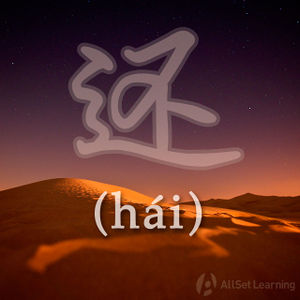Difference between revisions of "Expressing "and also" with "hai""
| Line 2: | Line 2: | ||
In English we use "and also" when we want to connect separate and different actions. We can do the same thing in Chinese by using 还 (hái). Another common way to express "also" is with the word 也 (yě). In the following examples on this page, 还 (hái) and 也 (yě) are interchangeable, but be careful, because the two words cannot be substituted for each other in many cases. | In English we use "and also" when we want to connect separate and different actions. We can do the same thing in Chinese by using 还 (hái). Another common way to express "also" is with the word 也 (yě). In the following examples on this page, 还 (hái) and 也 (yě) are interchangeable, but be careful, because the two words cannot be substituted for each other in many cases. | ||
| − | == Structure == | + | === Structure === |
The adverb 还 (hái) can be used to link two phrases together, in a similar way to "and also" in English. In this case, 还 (hái) begins a new phrase or clause. Note that in this structure, ONE subject is doing TWO different things, whereas when 也 (yě) is used as [[The "also" adverb]], TWO subjects are doing ONE thing. | The adverb 还 (hái) can be used to link two phrases together, in a similar way to "and also" in English. In this case, 还 (hái) begins a new phrase or clause. Note that in this structure, ONE subject is doing TWO different things, whereas when 也 (yě) is used as [[The "also" adverb]], TWO subjects are doing ONE thing. | ||
| Line 12: | Line 12: | ||
</div> | </div> | ||
| − | == Examples == | + | === Examples === |
<div class="liju"> | <div class="liju"> | ||
Revision as of 06:26, 3 July 2015
-
Level
-
Similar to
-
Used for
-
Keywords
In English we use "and also" when we want to connect separate and different actions. We can do the same thing in Chinese by using 还 (hái). Another common way to express "also" is with the word 也 (yě). In the following examples on this page, 还 (hái) and 也 (yě) are interchangeable, but be careful, because the two words cannot be substituted for each other in many cases.
Structure
The adverb 还 (hái) can be used to link two phrases together, in a similar way to "and also" in English. In this case, 还 (hái) begins a new phrase or clause. Note that in this structure, ONE subject is doing TWO different things, whereas when 也 (yě) is used as The "also" adverb, TWO subjects are doing ONE thing.
Subject + Verb + Object 1, 还 + Verb + Object 2
Examples
- 我 有 iPhone, 还 有 iPad。I have an iPhone, I also have an iPad.
- 我 会 说 中文,还 会 说 英文。I can speak Chinese, I can also speak English.
- 我 想 吃 冰淇淋,还 想 吃 巧克力。I want to eat ice cream, I also want to eat chocolate.
- 我 要 一 杯 咖啡, 还 要 一 个 蛋糕。I want a cup of coffee, I also want cake.
- 他 是 我 的 爸爸,还 是 我 的 朋友。He is my father, he is also my friend.
- 妈妈 做 了 四 个 菜,还 做 了 一 个 汤。My mom made four dishes, she also made soup.
- 我 买 了 肉,还 买 了 菜。I bought meat, I also bought vegetables.
- 我 想 去 北京,还 想 去 成都。I want to go to Beijing, I also want to go to Chengdu.
- 我 喝 了 白酒,还 喝 了 啤酒。I drank wine, I also drank beer.
- 我 喜欢 吃 苹果,还 喜欢 吃 香蕉。I like apples, I also like bananas.
See also
- Continuation with "hai"
- "In addition" with "zaishuo"
- "In addition" as "lingwai"
- Expressing "in addition" with "haiyou"



